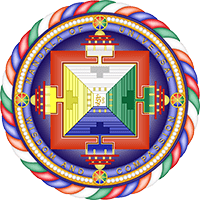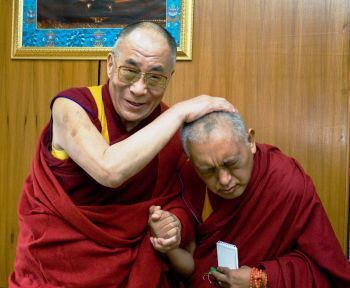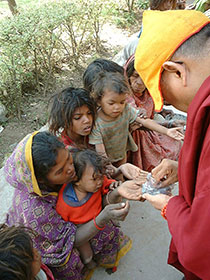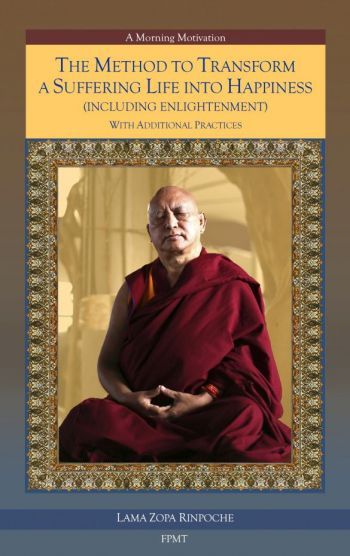- Home
- FPMT Homepage
Foundation for the Preservation of the Mahayana Tradition
The FPMT is an organization devoted to preserving and spreading Mahayana Buddhism worldwide by creating opportunities to listen, reflect, meditate, practice and actualize the unmistaken teachings of the Buddha and based on that experience spreading the Dharma to sentient beings. We provide integrated education through which people’s minds and hearts can be transformed into their highest potential for the benefit of others, inspired by an attitude of universal responsibility and service. We are committed to creating harmonious environments and helping all beings develop their full potential of infinite wisdom and compassion. Our organization is based on the Buddhist tradition of Lama Tsongkhapa of Tibet as taught to us by our founders Lama Thubten Yeshe and Lama Thubten Zopa Rinpoche.
- Willkommen
Die Stiftung zur Erhaltung der Mahayana Tradition (FPMT) ist eine Organisation, die sich weltweit für die Erhaltung und Verbreitung des Mahayana-Buddhismus einsetzt, indem sie Möglichkeiten schafft, den makellosen Lehren des Buddha zuzuhören, über sie zur reflektieren und zu meditieren und auf der Grundlage dieser Erfahrung das Dharma unter den Lebewesen zu verbreiten.
Wir bieten integrierte Schulungswege an, durch denen der Geist und das Herz der Menschen in ihr höchstes Potential verwandelt werden zum Wohl der anderen – inspiriert durch eine Haltung der universellen Verantwortung und dem Wunsch zu dienen. Wir haben uns verpflichtet, harmonische Umgebungen zu schaffen und allen Wesen zu helfen, ihr volles Potenzial unendlicher Weisheit und grenzenlosen Mitgefühls zu verwirklichen.
Unsere Organisation basiert auf der buddhistischen Tradition von Lama Tsongkhapa von Tibet, so wie sie uns von unseren Gründern Lama Thubten Yeshe und Lama Thubten Zopa Rinpoche gelehrt wird.
- Bienvenidos
La Fundación para la preservación de la tradición Mahayana (FPMT) es una organización que se dedica a preservar y difundir el budismo Mahayana en todo el mundo, creando oportunidades para escuchar, reflexionar, meditar, practicar y actualizar las enseñanzas inconfundibles de Buda y en base a esa experiencia difundir el Dharma a los seres.
Proporcionamos una educación integrada a través de la cual las mentes y los corazones de las personas se pueden transformar en su mayor potencial para el beneficio de los demás, inspirados por una actitud de responsabilidad y servicio universales. Estamos comprometidos a crear ambientes armoniosos y ayudar a todos los seres a desarrollar todo su potencial de infinita sabiduría y compasión.
Nuestra organización se basa en la tradición budista de Lama Tsongkhapa del Tíbet como nos lo enseñaron nuestros fundadores Lama Thubten Yeshe y Lama Zopa Rinpoche.
A continuación puede ver una lista de los centros y sus páginas web en su lengua preferida.
- Bienvenue
L’organisation de la FPMT a pour vocation la préservation et la diffusion du bouddhisme du mahayana dans le monde entier. Elle offre l’opportunité d’écouter, de réfléchir, de méditer, de pratiquer et de réaliser les enseignements excellents du Bouddha, pour ensuite transmettre le Dharma à tous les êtres. Nous proposons une formation intégrée grâce à laquelle le cœur et l’esprit de chacun peuvent accomplir leur potentiel le plus élevé pour le bien d’autrui, inspirés par le sens du service et une responsabilité universelle. Nous nous engageons à créer un environnement harmonieux et à aider tous les êtres à épanouir leur potentiel illimité de compassion et de sagesse. Notre organisation s’appuie sur la tradition guéloukpa de Lama Tsongkhapa du Tibet, telle qu’elle a été enseignée par nos fondateurs Lama Thoubtèn Yéshé et Lama Zopa Rinpoché.
Visitez le site de notre Editions Mahayana pour les traductions, conseils et nouvelles du Bureau international en français.
Voici une liste de centres et de leurs sites dans votre langue préférée
- Benvenuto
L’FPMT è un organizzazione il cui scopo è preservare e diffondere il Buddhismo Mahayana nel mondo, creando occasioni di ascolto, riflessione, meditazione e pratica dei perfetti insegnamenti del Buddha, al fine di attualizzare e diffondere il Dharma fra tutti gli esseri senzienti.
Offriamo un’educazione integrata, che può trasformare la mente e i cuori delle persone nel loro massimo potenziale, per il beneficio di tutti gli esseri, ispirati da un’attitudine di responsabilità universale e di servizio.
Il nostro obiettivo è quello di creare contesti armoniosi e aiutare tutti gli esseri a sviluppare in modo completo le proprie potenzialità di infinita saggezza e compassione.
La nostra organizzazione si basa sulla tradizione buddhista di Lama Tsongkhapa del Tibet, così come ci è stata insegnata dai nostri fondatori Lama Thubten Yeshe e Lama Zopa Rinpoche.
Di seguito potete trovare un elenco dei centri e dei loro siti nella lingua da voi prescelta.
- 欢迎 / 歡迎
简体中文
“护持大乘法脉基金会”( 英文简称:FPMT。全名:Foundation for the Preservation of the Mahayana Tradition) 是一个致力于护持和弘扬大乘佛法的国际佛教组织。我们提供听闻,思维,禅修,修行和实证佛陀无误教法的机会,以便让一切众生都能够享受佛法的指引和滋润。
我们全力创造和谐融洽的环境, 为人们提供解行并重的完整佛法教育,以便启发内在的环宇悲心及责任心,并开发内心所蕴藏的巨大潜能 — 无限的智慧与悲心 — 以便利益和服务一切有情。
FPMT的创办人是图腾耶喜喇嘛和喇嘛梭巴仁波切。我们所修习的是由两位上师所教导的,西藏喀巴大师的佛法传承。
繁體中文
護持大乘法脈基金會”( 英文簡稱:FPMT。全名:Found
ation for the Preservation of the Mahayana Tradition ) 是一個致力於護持和弘揚大乘佛法的國際佛教組織。我們提供聽聞, 思維,禪修,修行和實證佛陀無誤教法的機會,以便讓一切眾生都能 夠享受佛法的指引和滋潤。 我們全力創造和諧融洽的環境,
為人們提供解行並重的完整佛法教育,以便啟發內在的環宇悲心及責 任心,並開發內心所蘊藏的巨大潛能 — 無限的智慧與悲心 – – 以便利益和服務一切有情。 FPMT的創辦人是圖騰耶喜喇嘛和喇嘛梭巴仁波切。
我們所修習的是由兩位上師所教導的,西藏喀巴大師的佛法傳承。 察看道场信息:
- FPMT Homepage
- News/Media
-
- Study & Practice
-
-
- About FPMT Education Services
- Latest News
- Programs
- New to Buddhism?
- Buddhist Mind Science: Activating Your Potential
- Heart Advice for Death and Dying
- Discovering Buddhism
- Living in the Path
- Exploring Buddhism
- FPMT Basic Program
- FPMT Masters Program
- FPMT In-Depth Meditation Training
- Maitripa College
- Lotsawa Rinchen Zangpo Translator Program
- Universal Education for Compassion & Wisdom
- Online Learning Center
-
- Prayers & Practice Materials
- Overview of Prayers & Practices
- Full Catalogue of Prayers & Practice Materials
- Explore Popular Topics
- Benefiting Animals
- Chenrezig Resources
- Death & Dying Resources
- Lama Chopa (Guru Puja)
- Lama Zopa Rinpoche: Compendium of Precious Instructions
- Lama Zopa Rinpoche: Life Practice Advice
- Lama Zopa Rinpoche Practice Series
- Lamrim Resources
- Mantras
- Prayer Book Updates
- Purification Practices
- Sutras
- Thought Transformation (Lojong)
- Audio Materials
- Dharma Dates - Tibetan Calendar
- Translation Services
- Publishing Services
- Ways to Offer Support
- Prayers & Practice Materials
-
- Teachings and Advice
- Find Teachings and Advice
- Lama Zopa Rinpoche Advice Page
- Lama Zopa Rinpoche: Compendium of Precious Instructions
- Lama Zopa Rinpoche Video Teachings
- ༧སྐྱབས་རྗེ་བཟོད་པ་རིན་པོ་ཆེ་མཆོག་ནས་སྩལ་བའི་བཀའ་སློབ་བརྙན་འཕྲིན།
- Podcasts
- Lama Yeshe Wisdom Archive
- Buddhism FAQ
- Dharma for Young People
- Resources on Holy Objects
- Teachings and Advice
-
-
*If a menu item has a submenu clicking once will expand the menu clicking twice will open the page.
-
-
- Centers
-
- Teachers
-
- Projects
-
-
-
-
*If a menu item has a submenu clicking once will expand the menu clicking twice will open the page.
-
-
- FPMT
-
-
-
-
-
Practice with the bodhisattva attitude every day. People can’t see your mind; what people see is a manifestation of your attitude in your actions of body and speech. So pay attention to your attitude all the time. Guard it as if you are the police, or like a parent cares for a child, like a bodyguard, or as if you are the guru and your mind is your disciple.
Lama Zopa Rinpoche
-
-
-
- Shop
-
-
-
The Foundation Store is FPMT’s online shop and features a vast selection of Buddhist study and practice materials written or recommended by our lineage gurus. These items include homestudy programs, prayers and practices in PDF or eBook format, materials for children, and other resources to support practitioners.
Items displayed in the shop are made available for Dharma practice and educational purposes, and never for the purpose of profiting from their sale. Please read FPMT Foundation Store Policy Regarding Dharma Items for more information.
-
-
Lama Zopa Rinpoche News and Advice
5
Advice on Group Water Bowl Retreats at Home
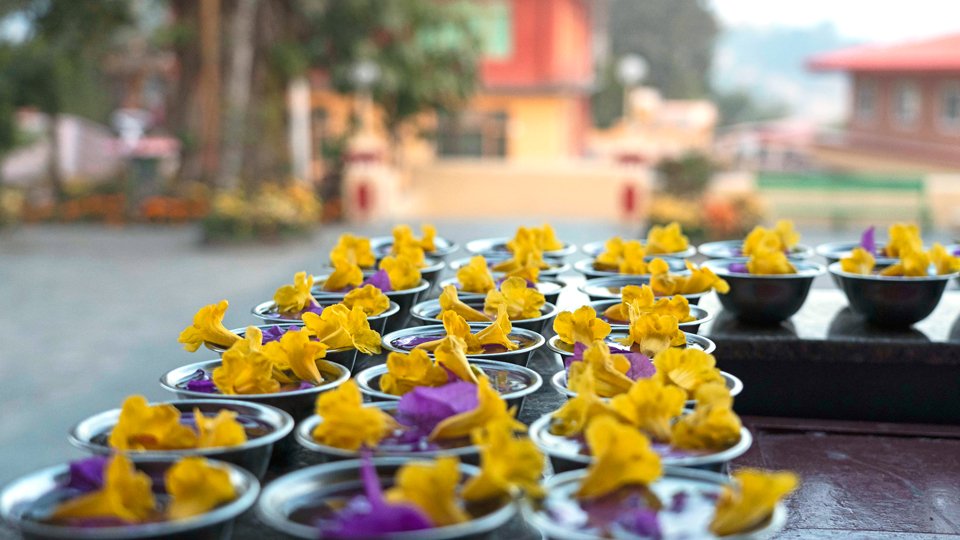
Extensive offerings on Lama Tsongkhapa Day, Kopan Monastery, December 2020. Photo by Ven. Lobsang Sherab.
Among the preliminary practices, only that of water bowl offerings can be done in a group practice and allows one to add the numbers accumulated by the group’s participants into one’s own count.
In 2020, a center director wrote to Lama Zopa Rinpoche asking whether participants in a group water bowl practice, who were doing the practice in their homes, could still count all the water bowls accumulated by the group, even though everyone was doing the practice separately. Rinpoche responded that yes, people can do water bowls separately in their own home as part of a group, and count all the water bowls made by the group participants as their personal accumulation.
To do this properly, Rinpoche explained, the participants would need to know who is in the water bowl practice group and they would all need to be doing the practice at the same time. So it wouldn’t work if one person offered the water bowls but another person in the group hadn’t finished doing their water bowls or if they didn’t do them that day. It needs coordination. For example, everyone who is part of a home water bowl offering group should agree to a specific time by which all the water bowls are completed. Then the water bowls can be collectively offered. If you do it this way, you can count all the bowls of those who are participating as your personal accumulation.
Rinpoche said that when you do the actual offering practice it is best if you not only offer the water bowls you are doing as a group, but all the water bowls at all the FPMT centers, projects, and services, and also Rinpoche’s house. And to have an even more vast offering, you can visualize the universes full of offerings.
The main reason for these practices is purification, Rinpoche explained. And that comes through experiencing difficulties and hardship in what you are doing. Of course, all these offerings create incredible merit when you visualize this way.
Just to be clear, one can’t include the count of all the water bowls in all the centers toward their own accumulation, but one can and should offer them.

Water bowl offering, Martigny, Switzerland, 2018. Photo by Harald Weichhart.
Several resources are available to support the practice of offering water bowls:
- Please refer to the newly updated booklet Extensive Offering Practice for the water bowl offering practice, which contains the “Actual Offering Prayer ” that is recited when one makes the actual offering.
- The Preliminary Practice of Altar Set-up & Water Bowl Offerings is a booklet that provides an explanation of how to set up a personal altar and how to make water bowl offerings.
- The water bowl offering practice can be done in the conjunction with a guru yoga practice, such as A Daily Meditation on Śākyamuni Buddha, Lama Tsongkhapa Guru Yoga, or Lama Chopa.
Lama Zopa Rinpoche is the spiritual director of the Foundation for the Preservation of Mahayana Tradition (FPMT), a Tibetan Buddhist organization dedicated to the transmission of the Mahayana Buddhist tradition and values worldwide through teaching, meditation and community service.
Watch Rinpoche’s recent teachings and find links to transcripts, MP3s, additional practice advice, and more on the page Lama Zopa Rinpoche’s Teachings on Thought Transformation during the Time of COVID-19.
3
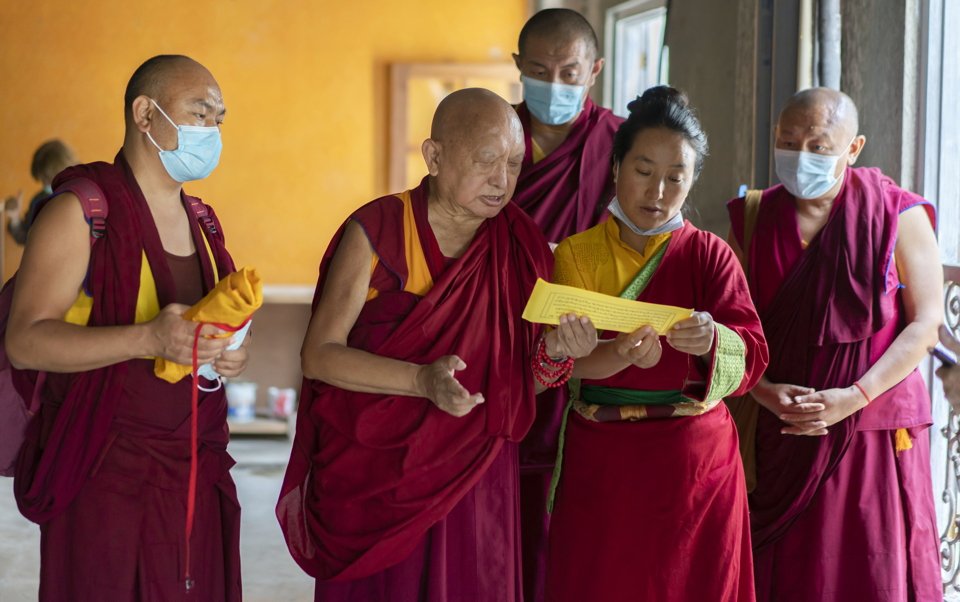
Rinpoche and Khadro-la doing prayer where the Himalayan Buddhist Meditation Centre, the FPMT center in Kathmandu, is going to be, Nepal, July 2021. Photo by Ven. Lobsang Sherab.
Lama Zopa Rinpoche continues his video teachings on thought transformation from Kopan Monastery in Nepal. Here is a summary of the most recent teaching:
Lama Zopa Rinpoche begins this teaching by referencing this quote by Thogme Sango in Thirty-Seven Practices of a Bodhisattva:
All sufferings come from desiring happiness for oneself.
Full enlightenment comes from the thought of benefitting others.
Therefore, exchanging one’s own happiness for the suffering of others
Is the practice of bodhisattvas.
Rinpoche gives commentary on this passage and explains that all undesirable things, all the sufferings we experience, come from desiring happiness for oneself. Therefore, exchanging one’s own happiness for the suffering of others is the practice of bodhisattvas.
When pleasure and problems happen, you can see whether or not you are practicing Dharma. When a problem comes, it is like you are completely drowned in the ocean. Instead of thinking of Dharma to solve and overcome your problem, you are “under” the problem, not having control over it. When pleasure comes, you are totally distracted by it, you are under the control of worldly concern and attachment, again—like you are drowning in the ocean. This is when you can see if you are practicing Dharma or not.
Because you are a human being, and not a stone or wood, you can benefit others. Even the ants or mosquitoes—you can make sure not to step on them, you can take them around holy objects, you can do what you can to benefit them. Reciting OM MANI PADME HUM three times and blowing on any sentient being purifies so much negative karma. If you aren’t living to benefit others, you are living a very dry, uninteresting, boring life! Using your life to achieve enlightenment is not boring at all.
Rinpoche then reviews the motivation for receiving oral transmissions and teachings. He also discusses the great yogi Thangtong Gyalpo in preparation for the oral transmissions he gives later in the teaching.
Before the oral transmissions, Rinpoche explains that the benefits of reciting and hearing OM MANI PADME HUM are extensive. Rinpoche lists many of these benefits and provides commentary on each:
- Reciting it one time purifies the four defeats of a fully ordained monk
- Reciting it purifies the five heavy negative karmas without a break
- Reciting it seven times purifies the negative karma of one hundred lifetimes
- Reciting it twenty-one times purifies the negative karma of 1,000 eons
- Reciting it 108 times purifies the negative karma of 40,000 eons
- Anyone who hears it gets a higher rebirth
- When you recite it, your mind is free from expectations and therefore pure
In short, Rinpoche stresses to us that we must recite OM MANI PADME HUM while we still have a perfect human rebirth.
Rinpoche then offers, “a million, zillion, trillion” thanks to everyone who join together on Saturdays for twenty-four hours to recite OM MANI PADME HUM for the COVID-19 pandemic. He also thanks everybody at Chenrezig Institute who arranged all the technical aspects that allow for this to happen online.
Rinpoche ends this video by offering commentary on and the oral transmissions in Tibetan of three prayers of Thangtong Gyalpo: “Liberating Sakya from Disease” (starting at 37:45 in the video), “Words of Truth Pacifying the Danger of Weapons” (39:45), and “A Request to Pacify the Fear of Famine” (42:57). Rinpoche also offers the oral transmission of King of Prayers (1:01:21), Homage to Tathagata Amitabha and Buddha Amitayus, A Brief Prayer to Be Reborn in Sukhavati (1:11:04), and The Array of Sukhavati Pure Land (1:13:15).
We invite you to go deeper into the topics presented here, plus many others, by watching Rinpoche’s video and reading the full transcript of Rinpoche’s teaching.
Watch Lama Zopa Rinpoche’s teaching “A Zillion Thanks to the Sangha for Reciting Manis During the Pandemic”:
https://youtu.be/D8v5VTdAANs
- Read the transcript of Rinpoche’s teaching
- Links to the oral transmission texts:
- The Vajra Speech of Mahasiddha Thangtong Gyalpo: The Blessed Prayer Known as “Liberating Sakya from Disease”
- The Vajra Speech of Mahasiddha Thangtong Gyalpo: Words of Truth Pacifying the Danger of Weapons
- The Speech of Mahasiddha Thangtong Gyalpo: A Request to Pacify the Fear of Famine
- King of Prayers
- Homage to Tathagata Amitabha and Buddha Amitayus, A Brief Prayer to Be Reborn in Sukhavati
- The Array of Sukhavati Pure Land
- Find Rinpoche’s Teachings on Thought Transformation translated into Spanish, Italian, French, Chinese, and Russian
- Dedication verses for COVID-19 Crisis Teachings
Watch more from the video series Lama Zopa Rinpoche’s Teachings on Thought Transformation during the Time of COVID-19 and find links to videos in transcripts, MP3s, additional practice advice, and more:
https://fpmt.org/fpmt/announcements/resources-for-coronavirus-pandemic/advice-from-lama-zopa-rinpoche-for-coronavirus/
Practice advice from our teachers, Dharma study-from-home opportunities, and more can be found on the page “Resources for the Coronavirus Pandemic.”
Lama Zopa Rinpoche is the spiritual director of the Foundation for the Preservation of Mahayana Tradition (FPMT), a Tibetan Buddhist organization dedicated to the transmission of the Mahayana Buddhist tradition and values worldwide through teaching, meditation and community service.
- Tagged: advice from lama zopa rinpoche, amitabha buddha, array of sukhavati pure land, coronavirus, king of prayers, lama zopa rinpoche advice for sangha, lama zopa rinpoche thought transformation video teaching, mahasiddha thangtong gyalpo’s prayers, oral transmission, thang thong gyalpo, thangtong gyalpo, video
2
Beauty Is in the Eye of the Beholder
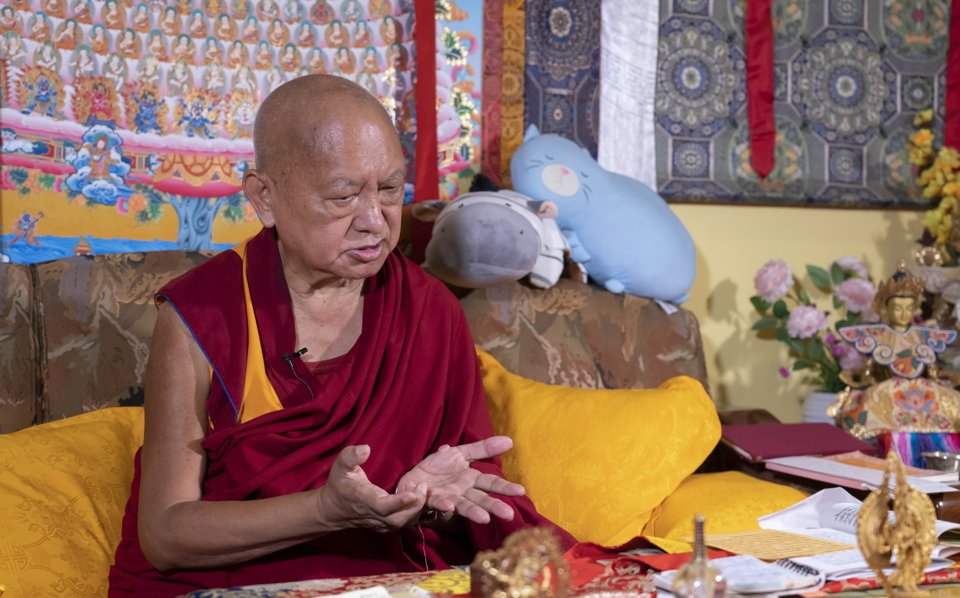
Lama Zopa Rinpoche giving an online teaching, Kopan Monastery, Nepal, July 2021. Photo by Ven. Lobsang Sherab.
Lama Zopa Rinpoche continues his video teachings on thought transformation from Kopan Monastery in Nepal. Here is a summary of the most recent teaching:
Rinpoche begins this teaching explaining that while he’s offering this teaching specifically to the Sangha at this time—to encourage them to keep their vows as those intent on the virtue that is nirvana—anyone is welcome to listen and benefit from the advice.
The total cessation of obscurations, is nirvana, ultimate happiness. It is forever, not like you are going on vacation, which is only temporary and is actually suffering, and not pleasure as your hallucinated mind believes. Because nirvana is everlasting happiness, it is worthwhile to bear hardships in order to practice Dharma. As an example, Rinpoche shares that Milarepa bore hardships such as living on nettles for many years and building a nine-story building three times alone, and then achieved enlightenment in a brief lifetime of degenerate times. This was due to all the hardships Milarepa experienced, not in spite of them. As another example, Rinpoche explains that the bodhisattva Always Crying One sacrificed himself to follow his guru and collected two great eons of merit in seven years’ time.
Right now you see samsara as a beautiful park in the same way that dogs see kaka as nectar. If you analyze it, you can see clearly that there is no pleasure existing from its own side. You label pleasure, but the mind is merely imputing this. The label came from the negative imprint left on the continuation of your consciousness since beginningless rebirths. Your entire life needs to be analyzed, then you recognize the truth. You discriminate “good” and “bad,” then attachment and anger arise. From there you create all the negative karma. This is why it is so important to learn Dharma! Everything is embodied in the lamrim, the three principal aspects of the path.
Samsaric pleasures cheat us, like honey on a knife. It is not only a hallucination, but it is what creates negative karma—not only suffering in this life but causes the lower realms. Being pierced by three hundred spears is nothing compared to a small suffering in hell. If you understood the suffering of hell, you would faint.
Grasping at samsaric pleasures is like a fish seeing a worm and getting caught on the hook. The fish sees the worm and thinks, “Oh! There’s something to eat!” They see pleasure and immediately jump toward it but then become hooked there and death follows. There are many examples like this—there is so much clinging to pleasure only to be cheated and destroyed by it.
Even beauty can’t be found when you analyze it. Someone you think of as so beautiful, visualize them without their skin. Then see them as a pile of skin, flesh, and bones—where is the beauty? Then using the example of blood: when the body is cut, one bleeds. This is frightening to see. Even the skin itself, if you looked at it with a magnifying glass, you can see all of the bumps. There’s no beauty to be attached to if you examine the body; it exists because you labeled it as beautiful, but this came from your mind. Your negative imprints project good and bad, you differentiate between beautiful and ugly, causing attachment and anger to arise. Without analyzing it looks like beauty comes from the outside, but that’s a total hallucination. This is why practicing mindfulness every day is necessary. It solves the wrong concept.
You can counteract attachment to someone’s body by thinking about what’s inside it—muscles, nerves, blood, flesh, skeleton. You can also counteract attachment to someone’s body by thinking it has a dirty smell when it isn’t washed and perfumed, or when it is dead.
Even insects project beauty onto other insects of the opposite sex and wish to have sex with them. The same is true for human beings; negative imprints cause us to see particular body parts as beautiful. From the side of the body, there is no beauty at all. It is difficult to take the lay vow to abstain from sexual misconduct because attachment overcomes the mind and defeats you. Then, celibacy for a monk or nun is very difficult. In reality, there is not one sentient being with whom you haven’t had a relationship. When you have so much attachment toward someone arise, you think this is the first time you are seeing them. But this person has been your wife and husband countless times; you have been their wife and husband countless times. There is not even one ant or insect you haven’t had a relationship with.
Until you have a stable mind, you should stay in a monastery, nunnery, cave, or hermitage. If your mind is weak, you should stay away from objects of desire. In this way, you are able to practice morality and keep your ordination.
We invite you to go deeper into the topics presented here, plus many others, by watching Rinpoche’s video and reading the full transcript of Rinpoche’s teaching.
Watch Lama Zopa Rinpoche’s teaching “Beauty Is in the Eye of the Beholder“:
https://youtu.be/S6hr1et8Qjg
- Read the transcript of Rinpoche’s teaching
- Find Rinpoche’s Teachings on Thought Transformation translated into Spanish, Italian, French, Chinese, and Russian
- Dedication verses for COVID-19 Crisis Teachings
Watch more from the video series Lama Zopa Rinpoche’s Teachings on Thought Transformation during the Time of COVID-19 and find links to videos in transcripts, MP3s, additional practice advice, and more:
https://fpmt.org/fpmt/announcements/resources-for-coronavirus-pandemic/advice-from-lama-zopa-rinpoche-for-coronavirus/
Practice advice from our teachers, Dharma study-from-home opportunities, and more can be found on the page “Resources for the Coronavirus Pandemic.”
Lama Zopa Rinpoche is the spiritual director of the Foundation for the Preservation of Mahayana Tradition (FPMT), a Tibetan Buddhist organization dedicated to the transmission of the Mahayana Buddhist tradition and values worldwide through teaching, meditation and community service.
- Tagged: advice from lama zopa rinpoche, coronavirus, lama zopa rinpoche advice for sangha, lama zopa rinpoche thought transformation video teaching, video
30
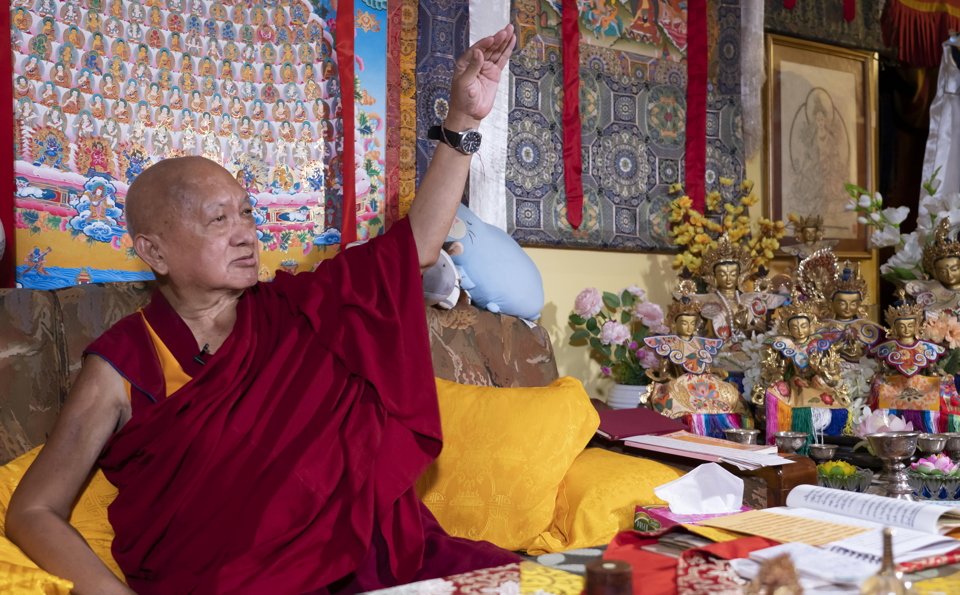
Lama Zopa Rinpoche teaching online from Kopan Monastery, Nepal, July 2021. Photo by Ven. Lobsang Sherab.
Lama Zopa Rinpoche continues his video teachings on thought transformation from Kopan Monastery in Nepal. Here is a summary of the most recent teaching:
Rinpoche begins this teaching by reminding us that the perfect human rebirth doesn’t last long. This body is like a machine—breathing in and out—and can stop at any time. Why does the body keep working? Karma. How long the breath lasts is also due to karma. It can stop at any time, we have to remember this. Some students have even died while using the bathroom. It can happen at any time, and when you don’t expect it, so while you are still breathing, make your life most beneficial for others by doing everything with bodhichitta.
The two basic practices in your life should be the two bodhichittas: absolute bodhichitta and conventional bodhichitta. Bodhichitta is the two wishes; one is the wish to benefit sentient beings, and one is the wish to achieve enlightenment. The real purpose of life is to benefit numberless sentient beings, to free them from suffering and bring them to enlightenment by yourself. Therefore, you need to achieve enlightenment. This is the motivation for listening to the teachings.
It is so important to know that samsaric pleasures are actually the suffering of change. Most students meditate on the suffering of pain, but they don’t meditate on how samsaric pleasures are in the nature of suffering, or on pervasive compounding suffering. This third type of suffering, the pervasive compounding suffering, is the most important to meditate on; it is the suffering of samsara. When you are free of this type of suffering, you become free from the other two sufferings, the suffering of pain and the suffering of change.
As Rinpoche mentioned yesterday, quoting from Lama Chopa verses 87cd-88ab, you have to renounce the thought of seeing samsara as a beautiful park:
Please bless me to generate a strong wish to be liberated
From the endless and terrifying great ocean of samsara.
Having renounced the thought seeing samsara,
Which is difficult to bear like being in prison, as a beautiful park,
You have to abandon this thought of the hallucinated mind.
If there were no negative imprints left on the mental continuum by ignorance, there would be no projection of a real I. Rinpoche explains how the thought focuses on the aggregates—form, feeling, cognition, compositional factors, and consciousness—and that is the phenomenon or base that is merely labeled “I.” When that happens, it is extremely fine, so subtle, Rinpoche emphasizes. It is not that the I doesn’t exist. The I exists, but it is like it doesn’t exist. The negative imprints left by ignorance on the continuation of our consciousness decorate the I that just now was merely imputed, projecting true existence, existing from its own side. So we think, “This is real. This is true!” Believing, holding onto that—that is ignorance. As you are creating ignorance, you are creating the root of samsara, the root of all suffering. This is from ignorance holding the I as truly existent.
Your hallucinated mind also makes up pleasure. If you check up on samsaric pleasure, you can see it is the basis of all suffering. Your mind labels it as pleasure. In reality, it is a hallucination, made up by the mind according to the different things an individual wants. Traveling, drugs, sex, going into the mountains—these various things are labeled pleasure according to the individual, but in reality there is nothing there at all. You have to recognize the hallucination as a hallucination. If you don’t look at the dream as a dream, you believe it is real. Then all of the problems of anger, ignorance, and attachment, all the delusions, arise.
We invite you to go deeper into the topics presented here, plus many others, by watching Rinpoche’s video and reading the full transcript of Rinpoche’s teaching.
Watch Lama Zopa Rinpoche’s teaching “Renounce the Thought Seeing Samsara as a Beautiful Park”:
https://youtu.be/ssivsxwZfYQ
- Read the transcript of Rinpoche’s teaching
- Links to Lama Chopa practices and commentary
- For more on bodhichitta and understanding ignorance, see Cultivating Mindfulness of Bodhichitta in Daily Activities and Recognizing the False I by Lama Zopa Rinpoche.
- Find Rinpoche’s Teachings on Thought Transformation translated into Spanish, Italian, French, Chinese, and Russian
- Dedication verses for COVID-19 Crisis Teachings
Watch more from the video series Lama Zopa Rinpoche’s Teachings on Thought Transformation during the Time of COVID-19 and find links to videos in transcripts, MP3s, additional practice advice, and more:
https://fpmt.org/fpmt/announcements/resources-for-coronavirus-pandemic/advice-from-lama-zopa-rinpoche-for-coronavirus/
Practice advice from our teachers, Dharma study-from-home opportunities, and more can be found on the page “Resources for the Coronavirus Pandemic.”
Lama Zopa Rinpoche is the spiritual director of the Foundation for the Preservation of Mahayana Tradition (FPMT), a Tibetan Buddhist organization dedicated to the transmission of the Mahayana Buddhist tradition and values worldwide through teaching, meditation and community service.
- Tagged: advice from lama zopa rinpoche, coronavirus, lama chopa, lama zopa rinpoche advice for sangha, lama zopa rinpoche thought transformation video teaching, video
29
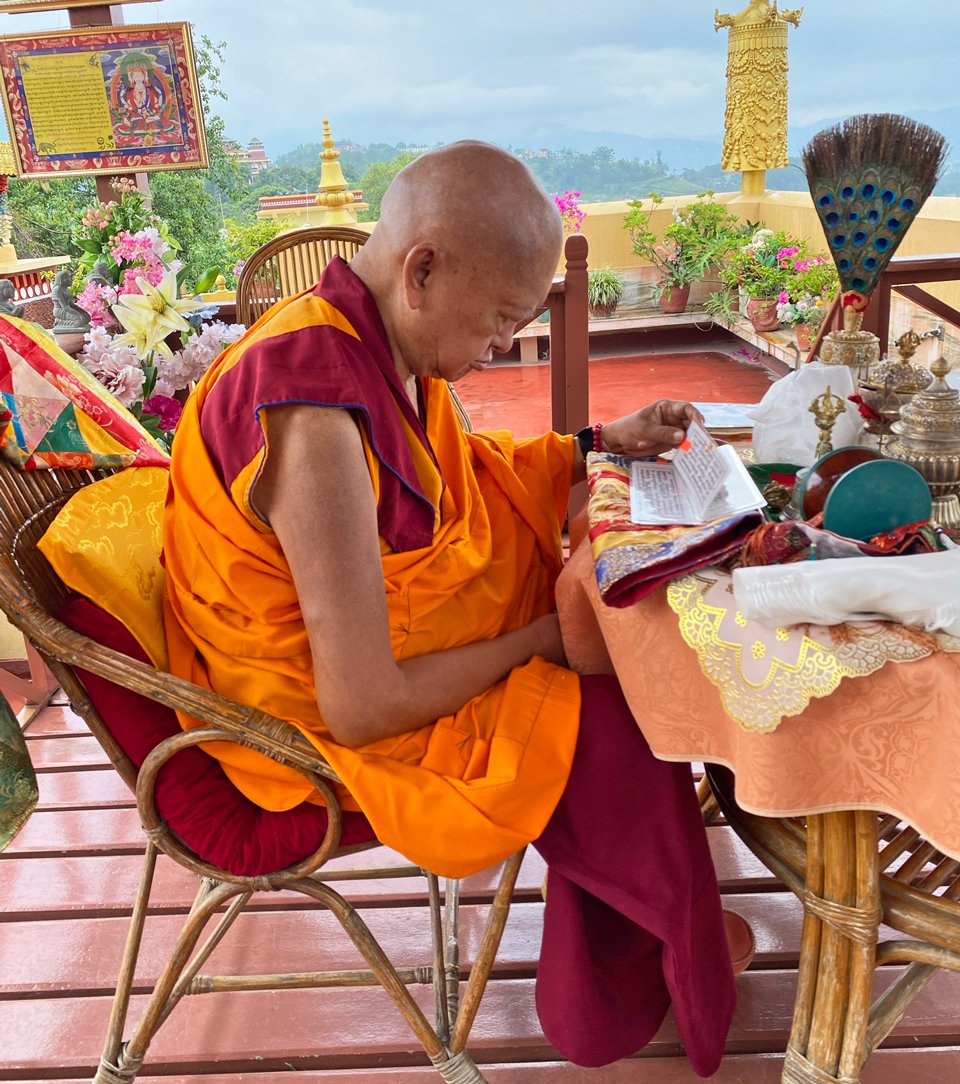
Lama Zopa Rinpoche consecrating the new stupa in Thame, Solu Khumbu, Nepal, from afar, Kopan Monastery, Nepal, June 2021. Photo by Ven. Roger Kunsang.
Lama Zopa Rinpoche continues his video teachings on thought transformation from Kopan Monastery in Nepal. Here is a summary of the most recent teaching:
Rinpoche begins this teaching by reminding us of the motivation he established last session, particularly for the Sangha. He emphasized requesting the guru for blessings to be able to generate a strong wish to be liberated from samsara, quoting verse 87 of Lama Chopa. Rinpoche adds that for this teaching’s motivation, we can look to verse 88 from Lama Chopa:
Having renounced the thought seeing samsara,
Which is difficult to bear like being in prison, as a beautiful park,
Please bless me to hold the three higher trainings, the treasure of the exalted beings’ wealth,
And then to uphold the victory banner of liberation.
In this way, the motivation is to renounce the thought of seeing samsara as a beautiful park. You don’t want to think like this even for a second.
People in the East look at life in the West as pleasurable, Rinpoche explains, but soon find out that the lifestyle is very expensive! Many Tibetans work hard all year to save money in order to make offerings to the monasteries. This is their way of collecting merit by doing something good each year. This is very different than the customs in the West, where people work hard just to support an expensive lifestyle. Rinpoche cautions that if your mind is not holy Dharma, your actions become nonvirtue. So even if you give all of your money to the monastery, your motivation is what determines whether this is worldly dharma, resulting in future suffering, or holy Dharma, which is the cause of happiness.
Rinpoche then discussed going on pilgrimage to Gyalwa Dromtonpa’s monastery in Tibet. Gyalwa Dromtonpa was Lama Atisha’s translator in Tibet. Lama Atisha asked Dromtonpa to establish a monastery [known as Reting Monastery]. Lama Tsongkhapa wrote Lamrim Chenmo in a hermitage above the monastery. It is a great monastery from where many Kadampa geshes came. This monastery also holds a very precious statue of Guhyasamaja Manjushri Vajra. This was Lama Atisha’s devotion holy object, which he gave Dromtonpa. If you drink the water there, you never get reborn in the lower realms. So everyone on the pilgrimage drank the water. Gold was offered to the statue, as well as a pearl mala and a bath (tru söl).
Gyalwa Dromtonpa said that practicing holy Dharma means you renounce this life. Renouncing this life means giving up attachment clinging to this life. All the sufferings, all the problems, all nonvirtue—all of this comes from the root, which is the eight worldly concerns, clinging to the pleasures of this life. So renouncing means giving this up. There is more and more dissatisfaction the more wealth you have. It is the worst suffering. Even though you have everything materially, the mind suffers unbelievably. Rich people look at poor people and think they are happier than them, but having that much wealth causes so many mental problems and so much suffering. Being in samsara is like being in the center of a fire, like sitting on top of a needle, like being in prison.
The essential path to become free from samsara is the practice of the three higher trainings: morality, concentration, and wisdom.
Rinpoche then discusses why it is so important to be Sangha. Lama Tsongkhapa explained in Lamrim Chenmo that being ordained makes it easy to practice the higher training of morality—which is the base of all realizations. Generally, Sangha have more time to practice Dharma than lay people. This is because many lay people get caught in family life and there is no time to practice and actualizing the path becomes very difficult. Due to having more freedom to practice, Sangha can develop renunciation and then compassion. This is why it is very important to have the motivation to request the guru for blessings to be able to uphold the three higher trainings and receive liberation.
Your view depends on how pure or impure your mind is. What you see on the outside is all according to your mind. The more impure your mind is, the more impure things appear outside. If your mind is more pure, you will see things outside as pure also. To a Buddha, whatever appears is only a pure appearance—negative imprints are totally removed, and there is no dualistic view.
Attachment and anger arise only after you discriminate “good” or “bad.” Lama Tsongkhapa mentioned this in Lamrim Chenmo:
Ignorance, which is in the nature of exaggeration, exaggerates the differentiation into
good and bad. Then attachment and anger arise. Therefore, the way of holding [objects]
by these [wrong concepts] can also be gotten rid of by logic.
Real pleasure is a hallucination. You must recognize the nature of suffering in samsara. The renunciation of samsara is so important because you are constantly suffering until you are free from it. Rinpoche quotes a verse from Lama Tsongkhapa’s Foundation of All Good Qualities to support his point:
By recognizing the shortcomings of samsaric perfections—
There is no satisfaction in enjoying them, they are the door
to all sufferings,
And they cannot be trusted—
Please bless me to generate a strong wish for the happiness of liberation.
This is an incredible teaching, Rinpoche says. The more you enjoy samsaric pleasures, the more dissatisfied you become. Drinking alcohol, taking drugs, relationships, sex—all of this leads to more dissatisfaction. It all makes your life so difficult and after death then your new home is in the lower realms. This whole mistake is due to ignorance.
By thinking of others’ suffering you can’t relax! You have to practice Dharma; you have to at least recite OM MANI PADME HUM to purify them, free them from samsara, and bring them to enlightenment. Even if you don’t know anything or don’t accept Dharma, if you have a good heart you can help people and protect them from suffering.
We invite you to go deeper into the topics presented here, plus many others, by watching Rinpoche’s video and reading the full transcript of Rinpoche’s teaching.
Watch Lama Zopa Rinpoche’s teaching “Practicing Morality Is Easy When You Know Real Pleasure Is a Hallucination“:
https://youtu.be/eYdfD_HLGKA
- Read the transcript of Rinpoche’s teaching
- Links to Lama Chopa practices and commentary
- Foundation of All Good Qualities (eBook & PDF) by Lama Tsongkhapa
- Find more resources for lamrim study, including links to Lamrim Chemno by Lama Tsongkhapa
- Find Rinpoche’s Teachings on Thought Transformation translated into Spanish, Italian, French, Chinese, and Russian
- Dedication verses for COVID-19 Crisis Teachings
Watch more from the video series Lama Zopa Rinpoche’s Teachings on Thought Transformation during the Time of COVID-19 and find links to videos in transcripts, MP3s, additional practice advice, and more:
https://fpmt.org/fpmt/announcements/resources-for-coronavirus-pandemic/advice-from-lama-zopa-rinpoche-for-coronavirus/
Practice advice from our teachers, Dharma study-from-home opportunities, and more can be found on the page “Resources for the Coronavirus Pandemic.”
Lama Zopa Rinpoche is the spiritual director of the Foundation for the Preservation of Mahayana Tradition (FPMT), a Tibetan Buddhist organization dedicated to the transmission of the Mahayana Buddhist tradition and values worldwide through teaching, meditation and community service.
- Tagged: advice from lama zopa rinpoche, coronavirus, lama zopa rinpoche advice for sangha, lama zopa rinpoche thought transformation video teaching, renunciation, sangha, three higher trainings, video
26

Lama Zopa Rinpoche giving an online teaching, Kopan Monastery, Nepal, July 2021. Photo by Ven. Lobsang Sherab.
Lama Zopa Rinpoche continues his video teachings on thought transformation from Kopan Monastery in Nepal. Here is a summary of the most recent teaching:
Lama Zopa Rinpoche begins this teaching discussing two important and powerful holy objects.
First, Rinpoche discussed the three-story Padmasambhava (Guru Rinpoche) statue being built in Maratika, Nepal, to pacify war, famine, and disease—and, of course, for all the six-realm sentient beings, who have been suffering from beginningless rebirths, to be free from samsara and achieve enlightenment.
Then, Rinpoche discusses the Maitreya Buddha statue being built in Bodhgaya, India, on the land offered to His Holiness the Dalai Lama. This statue is also being built to pacify war, famine, and disease.
Rinpoche explains that one can never know what is going to happen. There are earthquakes, landslides, flooding, and other disasters of the elements. There can also be viruses, famine, war—all kinds of things can happen in samsara. Even in places like Germany, no one expected flash floods there, but they occurred. These dangers actually come from people’s minds, from their karma. So even in an area where a certain disaster wouldn’t be expected, it can happen. Most people don’t have the merit to understand karma, so they believe in the wrong things and attribute causes to the wrong things.
Because Buddhism explains the mind, studying it is important, Rinpoche says, even if you don’t believe it! Even if you are not practicing or believing, you are developing wisdom by studying the Dharma.
Due to practicing Dharma, karma can ripen as suffering in this life rather than in the hell realm. This is due to purification from practicing virtue. Instead of having to experience the heaviest suffering for eons, the karma ripens as some catastrophe in this life, and then there will be happiness in the future.
Rinpoche illustrates this point, quoting Kadampa Geshe Kharag Gomchung from Mind Training: The Seventy-Two Exhortations:
Even this small present suffering
Finishes past heavy negative karma,
And then in the future there will be happiness.
Therefore, feel happy with your suffering.
Rinpoche then discusses verses 85–87 from Lama Chopa:
Realizing how this perfect human body of freedoms and richnesses
Is found only one time, is difficult to find again, and easily perishes,
Please bless me to make it meaningful and take its essence,
Without being distracted by the meaningless activities of this life.
Being afraid of the blazing suffering of the lower realms,
Please bless me to voluntarily persevere in
Going for refuge from my heart to the Three Rare Sublime Ones,
Abandoning negative karma, and practicing all the collections of virtue.
Violently tossed by the waves of afflicted actions and disturbing thoughts,
Harmed by the many water lions of the three types of suffering,
Please bless me to generate a strong wish to be liberated
From the endless and terrifying great ocean of samsara.
The first verse means we must make this perfect human rebirth truly meaningful. Then, we request the guru for blessings to go for refuge, abandon negative karma, and practice virtue. Rinpoche uses Milarepa as an example of how to practice this. Milarepa took on hardships purposefully. Many thought he was very poor and had nothing—but he achieved the whole path to enlightenment. Many people might think, “I have a job, I have money, I have an education.” They achieved whatever they needed to achieve, but they are still suffering in samsara because they don’t know Dharma.
Rinpoche emphasizes that it is so important to request the guru for blessings to generate a strong wish to be liberated from the great ocean of samsara. We should request this single-pointedly, making the strongest request.
This is the motivation we should have for listening to the teachings.
Rinpoche reminds us that our personal suffering in samsara is nothing compared to that of numberless sentient beings, who have suffered since beginningless rebirths. Practicing the higher training of morality is the foundation for helping all the numberless sentient beings. We are solely responsible for freeing them from oceans of samsaric suffering and bringing them to full enlightenment.
In order to do this, we need to achieve enlightenment so that we can do perfect work for others. To do this we need to be free from samsara. And to do that we must actualize the three higher trainings of morality, concentration, and wisdom. Rinpoche explains that the higher training of morality is the very foundation, and so it is most important to practice morality. “So therefore, now SANGHA—for yourself to end samsara as quickly as possible and achieve enlightenment to help numberless sentient beings, so then it is better to be a monk or nun,” Rinpoche concludes.
We invite you to go deeper into the topics presented here, plus many others, by watching Rinpoche’s video and reading the full transcript of Rinpoche’s teaching.
Watch Lama Zopa Rinpoche’s teaching “The Higher Training of Morality Is the Foundation for Helping Sentient Beings”:
https://youtu.be/beY7voGsWXE
- Read the transcript of Rinpoche’s teaching
- Links to Lama Chopa practices and commentary
- Find Rinpoche’s Teachings on Thought Transformation translated into Spanish, Italian, French, Chinese, and Russian
- Dedication verses for COVID-19 Crisis Teachings
Watch more from the video series Lama Zopa Rinpoche’s Teachings on Thought Transformation during the Time of COVID-19 and find links to videos in transcripts, MP3s, additional practice advice, and more:
https://fpmt.org/fpmt/announcements/resources-for-coronavirus-pandemic/advice-from-lama-zopa-rinpoche-for-coronavirus/
You can read a summary of Rinpoche’s thought transformation teachings given in 2020 in the Mandala 2021 article “The Time to Practice Is Now: Lama Zopa Rinpoche’s Thought Transformation Teachings During the Time of COVID-19.”
Lama Zopa Rinpoche is the spiritual director of the Foundation for the Preservation of Mahayana Tradition (FPMT), a Tibetan Buddhist organization dedicated to the transmission of the Mahayana Buddhist tradition and values worldwide through teaching, meditation and community service.
- Tagged: advice from lama zopa rinpoche, coronavirus, lama zopa rinpoche advice for sangha, lama zopa rinpoche thought transformation video teaching, three higher trainings, video
22
Cherishing Others Versus Cherishing Oneself
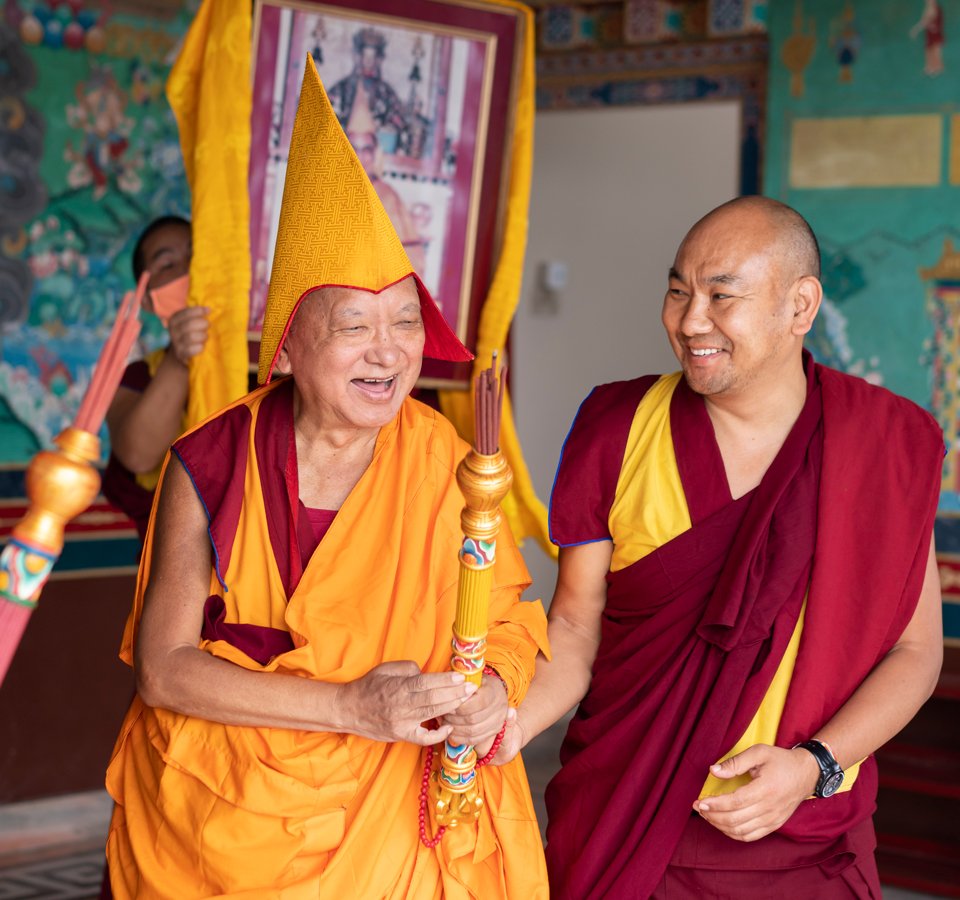
Lama Zopa Rinpoche on His Holiness the Dalai Lama’s birthday, Kopan Monastery, Nepal, July 2021. Photo by Ven. Lobsang Sherab.
In the following video excerpt Lama Zopa Rinpoche explains the advantages of cherishing others over cherishing oneself. Here’s a summary:
Rinpoche begins by sharing a story he heard from Gelek Rinpoche during a teaching many years ago in Delhi. The story was about how poor workers building roads out in the hot sun would see wealthy people in their nice houses and be attracted to their lives. But the rich people, thinking of their problems, would look at the workers and think, “I wish I could be like those people working on the road; they don’t have all these problems.” Rinpoche continues, describing how when we see a bird or a monkey or a mouse, we get attracted to them because we think that we have so many problems and that the animals have none. But we don’t know the suffering of the animals.
Rinpoche then explains that whatever we do, even studying the Dharma, reciting prayers, meditating, eating, or sleeping, if we do these things with the self-cherishing thought, they become obstacles to achieve enlightenment.
“Guru Shakyamuni Buddha, like the numberless buddhas, was in the beginning like us. But they all gave up the self-cherishing thought, the greatest obstacle to achieving enlightenment, the root of suffering, obstacles, all the obstacles to practicing Dharma, even the black magic, everything. So they changed their minds; they gave up the self-cherishing thought. Their minds changed into bodhichitta, cherishing the numberless sentient beings. For us, we cherish I, they cherish the numberless sentient beings and most happily let go of I. They let go of cherishing I, most happily, kind of with force,” Rinpoche says.
If you realize the benefits of cherishing others over yourself and you meditate and analyzed these two things you come to see that the unbelievable benefits of cherishing others are limitless like the sky. Rinpoche explains that the self-cherishing mind doesn’t allow you to achieve enlightenment, Buddhahood for sentient beings. It keeps you in the suffering of samsara.
So while we have received this perfect human rebirth, which is quickly coming to an end, we should put our efforts toward transforming our minds in order to actualize bodhichitta. Rinpoche explains that by thinking of the benefits of cherishing others and the shortcomings of the self-cherishing thought, and of the kindness of other sentient beings, and on the basis of loving kindness and great compassion, we should be moving our minds as much as we can to bodhichitta. So that with every activity we are remembering bodhichitta, dedicating for sentient beings. “So each time when you dedicate the activity for sentient beings, you collect merits, unbelievable [the number of merits, like] the number of [specks of] dust of this earth, the limitless sky, or more than that, depending on the attitude,” Rinpoche explains.
Watch the video “Cherishing Others Versus Cherishing Oneself”:
https://youtu.be/sTfUu0dZzXo
The above video is extracted from the 2018 retreat at the Great Stupa of Universal Compassion in Bendigo, Australia. You can find more blogs with short video clips from Rinpoche’s teaching as well as the complete collection of these “Essential Extracts” videos on FPMT.org.
Watch the ongoing video series Lama Zopa Rinpoche’s Teachings on Thought Transformation, where you can also find links to transcripts, MP3s, additional practice advice, and more. You can read a summary of Rinpoche’s thought transformation teachings given in 2020 in the Mandala 2021 article “The Time to Practice Is Now: Lama Zopa Rinpoche’s Thought Transformation Teachings During the Time of COVID-19.”
Lama Zopa Rinpoche is the spiritual director of the Foundation for the Preservation of Mahayana Tradition (FPMT), a Tibetan Buddhist organization dedicated to the transmission of the Mahayana Buddhist tradition and values worldwide through teaching, meditation and community service.
20
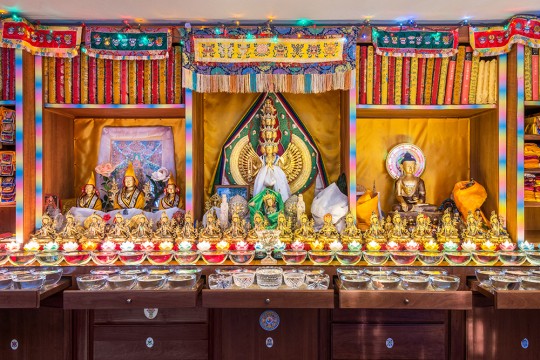
It takes Sangha many hours each day to offer water bowls as part of the extensive offerings at Kachoe Dechen Ling.
Since 1999, Lama Zopa Rinpoche has arranged to have continual extensive offerings of water bowls and lights offered twenty-four hours a day, 365 days a year to create merit for the FPMT organization. Since this began over two decades ago, these offerings have been increasing and are now happening in various parts of the world.
Lama Zopa Rinpoche has explained, “We are not aware of the limitless skies of benefits we achieve from the practice of offering, what we can achieve and enjoy from life to life. Even while you are in samsara, you enjoy good rebirths, wealth, and every happiness. Even just the samsaric perfections are amazing, without adding all those incredible realizations that allow us to offer deep benefit to sentient beings, liberating them from oceans of samsaric suffering and its cause, delusion and karma.”
Rinpoche personally incorporates all of these actual physically made offerings in his daily practices and when doing food offerings he sometimes leads an extensive practice where all of the offerings are visualized and multiplied and then mentally offered to Buddha, Dharma, Sangha and all the holy objects around the world.
Rinpoche advises students, whenever making offerings in our practice, that we can also remember all the other arranged offerings in Kachoe Dechen Ling, CA, US; Buddha Amitabha Pure Land, WA, US; and also in all the FPMT centers around the world, by using these actual offerings as a basis and then visualizing and multiplying them. In this way, we can join in the merit from those having made these extensive offerings every day.
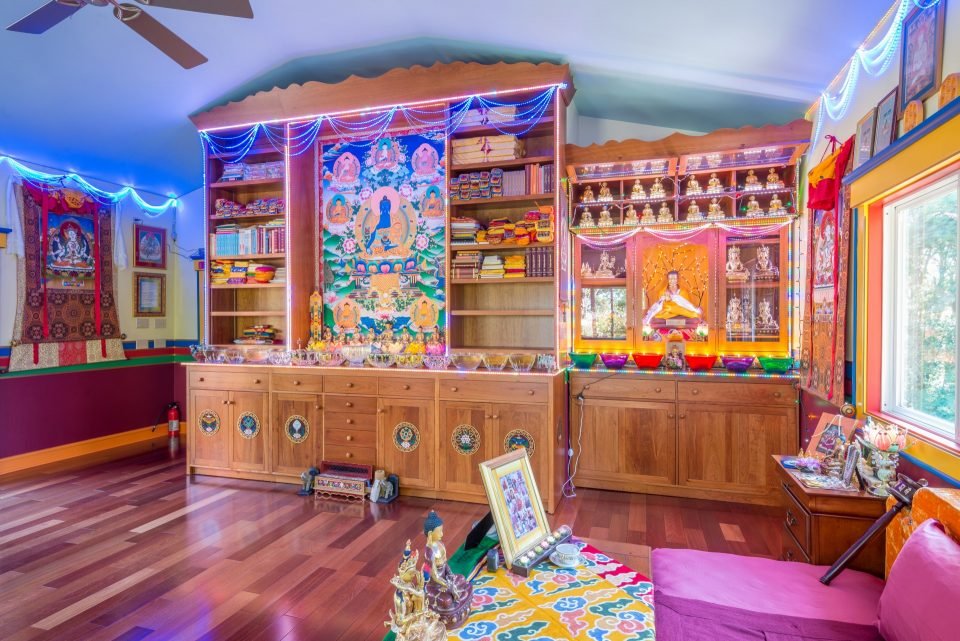
Extensive offerings at Kachoe Dechen Ling, CA, US.
Please Rejoice in Some of the Extensive Offerings Around the World
- Thousands of light offerings, hundreds of water bowls, and a garden full of flower offerings at Kachoe Dechen Ling, CA, US.
- Thousands of light offerings, hundreds of water bowls, and a garden full of flower offerings at Buddha Amitabha Pure Land, WA, US.
- Thousands of light offerings, hundreds of water bowls, and gardens full of flowers offerings at Root Institute, Bodhgaya, India.
- Thousands of lights, hundreds of water bowls and gardens full of flower offering at Kopan Monastery, Nepal.
- 100,000 lights continually offered at Amitabha Buddhist Centre (ABC), Singapore.
- 100,001 lights continually offered at Chokyi Gyaltsen Center, Malaysia.
- Thousands of water bowl offerings, extensive light offerings at Ganden Do Ngag Shedrub Ling Center, Mongolia. These offerings are made daily by a group of very dedicated elderly volunteers.
- Continually burning butter lamp in front of precious stupa with Trulshik Rinpoche’s holy body in Chailsa, Nepal.
- Continually burning butter lamp in front of Guru Lhakang, Thubten Choeling, Chailsa, Nepal
Please rejoice and remember all these extensive offerings that happen every moment of every day!
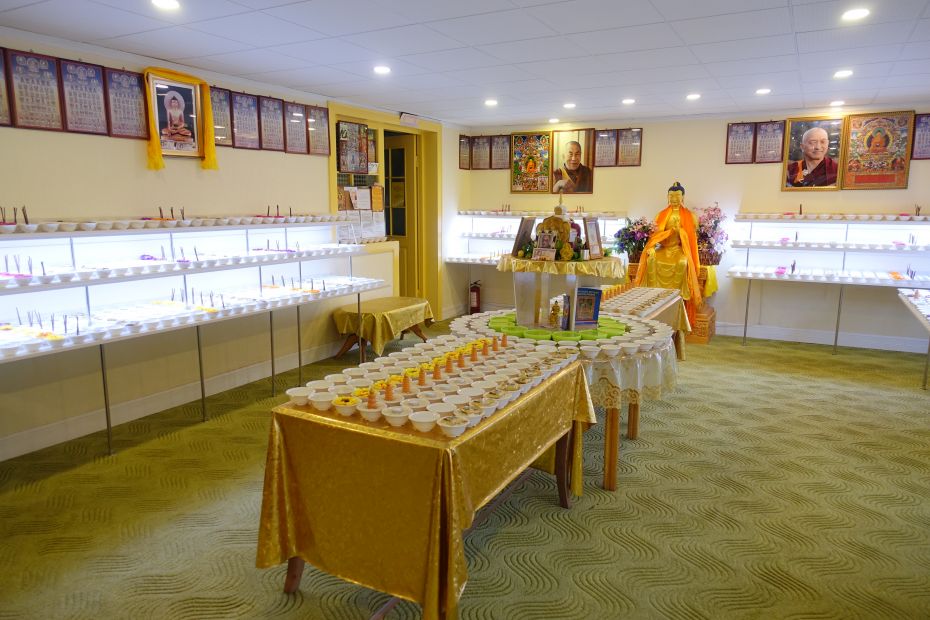
Water bowls and extensive offerings at Ganden Do Ngag Shedrub Ling Center, Mongolia, offered by a dedicated group of elderly volunteers.
The Actual Offering Prayer
The actual offering prayer is recited five times, ten times, one thousand times, or however many times you want to make offerings.
These clouds of (light) offerings, both actually arranged and mentally emanated, filling space,
Are manifestations of my own innate awareness, the dharmakāya.
These clouds of offerings equaling the sky,
I offer to all the gurus, the Three Rare Sublime Ones,
And all the statues, stūpas, and scriptures, which are manifestations of my guru.
By the merits of generating bodhicitta, making charity to the numberless sentient beings, and making these (light) offerings to the gurus, the Three Rare Sublime Ones, and all the holy objects in the ten directions—
For all those sentient beings who rely upon me,
All those for whom I have promised to pray,
All those whose names have been given to me,
And, principally, those who have a connection with me, my servants, benefactors, and disciples
As well as all remaining transmigratory beings, both living and dead—
May the rays of the lights of the five wisdoms completely purify
all their degenerated vows and samayas right now!
May all the sufferings of the evil-gone realms cease right now!
May the three realms of saṃsāra be emptied right now!
May all impure minds and obscurations be purified right now!
May all impure appearances be purified right now!
May the five holy bodies and wisdoms spontaneously arise!
—From Extensive Offering Practice: A Practice to Accumulate the Most Extensive Merit with Light and Other Offerings by Lama Zopa Rinpoche
Through the Lama Zopa Rinpoche Bodhichitta Fund Rinpoche supports a number of Sangha to make many of these offerings daily, as well as covering the cost of electricity for the extensive light offerings at Kachoe Dechen Ling, Buddha Amitabha Pure Land, Kopan Monastery in 2021, and Root Institute, as well as the butter for the continual light offerings in Nepal and also occasionally the meals to the kind volunteers of Ganden Do Ngag Shedrub Ling Center, Mongolia.
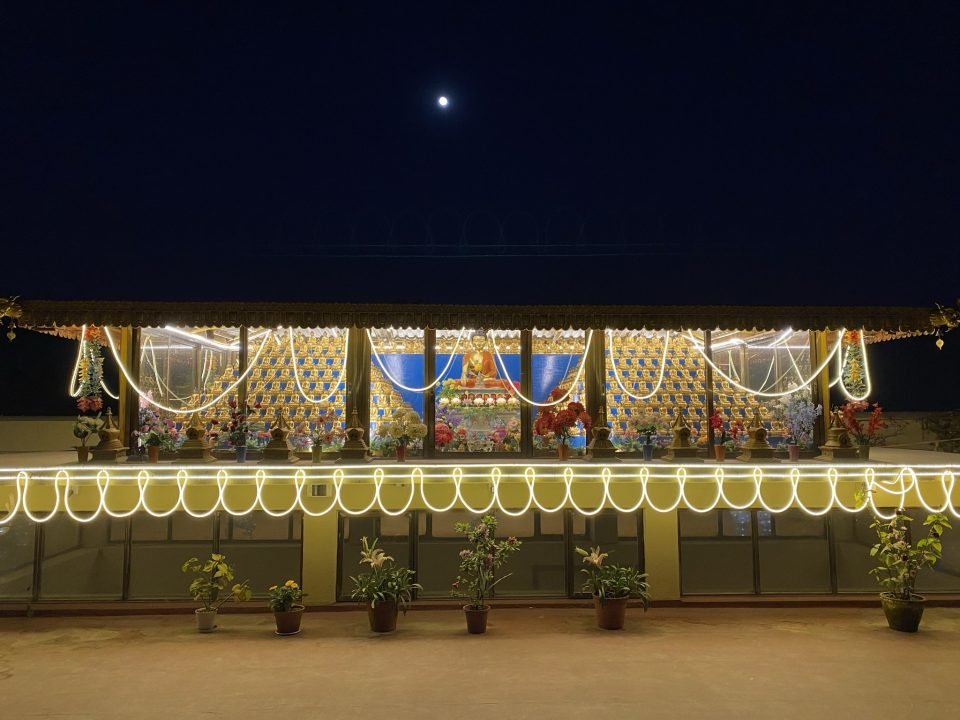
Extensive offerings at Kopan Monastery, Nepal.
You can learn more about the many beneficial activities of the Lama Zopa Rinpoche Bodhichitta Fund or other Charitable Projects of FPMT.
19
Beauty Comes from Your Mind
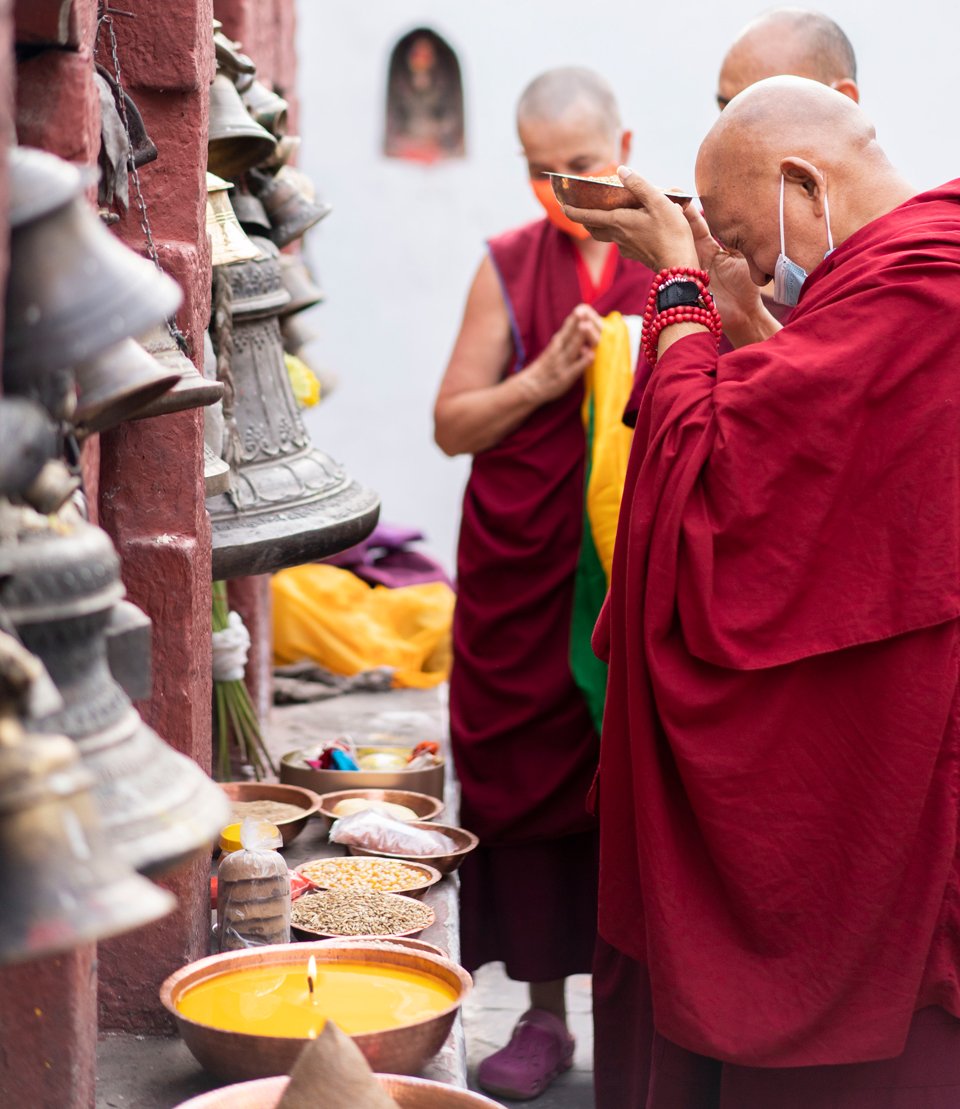
Lama Zopa Rinpoche making offerings at Boudha Stupa after lockdowns were lifted, Nepal, June 2021. Photo by Ven. Lobsang Sherab.
In the following short excerpt from Lama Zopa Rinpoche’s video teachings on thought transformation, Rinpoche explains that attachment to others’ bodies comes from the beginningless habituation of thinking they are nice. This is not only true of human beings, but even insects have this attraction to the opposite sex.
Also, Rinpoche explains that our attachment changes. For example, our attraction to one person can disappear when we see someone who we think is even more attractive. This proves that attachment does not come from the side of the object, the other person’s body; it comes from our own mind.
“That means you have freedom in your hands. Hell and enlightenment, liberation from samsaric suffering, and nirvana—yes, even everyday problems and happiness—it is in your hands. It depends on how you think,” Rinpoche explains.
“If you keep your mind in Dharma, especially in bodhichitta, lojong, emptiness, it is unbelievable—only happiness! With bodhichitta, everything becomes a cause of enlightenment. With emptiness, everything becomes a remedy to samsara, everything that you do.”
Rinpoche emphasizes that we must understand that thinking that something is beautiful or ugly does not come from the object’s side. Thinking that is an exaggeration that comes from your own mind. Therefore, since our own mind produces attachment, our own mind also can become free from attachment.
Watch the video “Beauty Comes from Your Mind“:
https://youtu.be/-IzXuyTkW00
Read the transcript of Rinpoche’s teaching.
The above video is extracted from the teaching “Attachment to Pleasure Cheats You” (Video 50, July 12, 2020).
Read a summary of Rinpoche’s thought transformation teachings given in 2020 in the Mandala 2021 article “The Time to Practice Is Now: Lama Zopa Rinpoche’s Thought Transformation Teachings During the Time of COVID-19.” Watch more from the video series Lama Zopa Rinpoche’s Teachings on Thought Transformation, where you can also find links to transcripts, MP3s, additional practice advice, and more. Find more short video clips from Rinpoche’s teaching, or “Essential Extracts.”
Lama Zopa Rinpoche is the spiritual director of the Foundation for the Preservation of Mahayana Tradition (FPMT), a Tibetan Buddhist organization dedicated to the transmission of the Mahayana Buddhist tradition and values worldwide through teaching, meditation and community service.
- Tagged: advice from lama zopa rinpoche, attachment, essential extract, essential extract thought transformation teachings, video
14
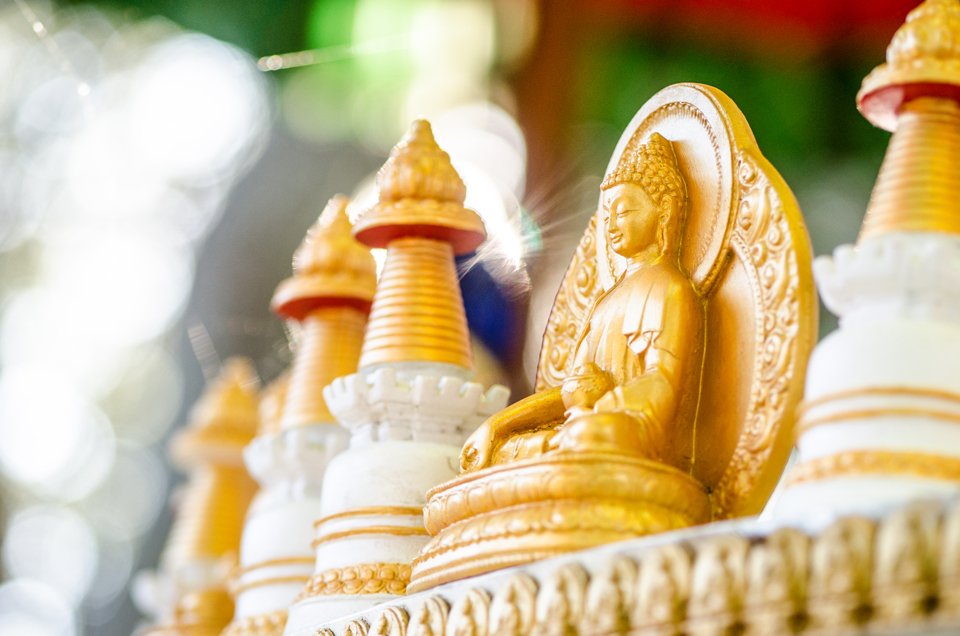
Tsa-tsas at Kachoe Dechen Ling, Aptos, California, US. Photo by Chris Majors.
Lama Zopa Rinpoche dictated this advice on making tsa-tsas and requested that it be made available to all who do the practice of tsa-tsas.
If you do nine tsa-tsas according to the tradition of Lama Atisha, prepare everything according to what is normally instructed for making tsa-tsas.
When you make the first tsa-tsa think and dedicate: I will make this tsa-tsa to complete all the wishes of the holy mind that the three times (past, present, and future) virtuous friend has.
Second tsa-tsa: Dedicate, thinking to purify: May the tsa-tsa purify completely, purify the obscurations, and accumulate the merits of all the fathers and mothers of the past, present, and future.
Third tsa-tsa: Dedicate to purify the obscurations and the negative karma of having collected the five heavy negative karmas without interruption of myself and all sentient beings.
Fourth tsa-tsa: Dedicate for myself and every sentient being to not be reborn in the eight states, which have no freedom to practice Dharma.
Fifth tsa-tsa: Dedicate, particularly, for myself and every sentient being to not be reborn in the three lower realms.
Sixth tsa-tsa: Dedicate to heal all the diseases of all the sick people, myself, and every sentient being.
Seventh tsa-tsa: Dedicate that all devas who are dying not be reborn in a suffering world.
Eighth tsa-tsa: Dedicate for intermediate state beings (to not have fear, to not suffer, and to be born in a pure land where they can become enlightened or attain a perfect human body and meet Dharma in order to achieve enlightenment).
Ninth tsa-tsa: Dedicate for all the sentient beings (to purify all the obscurations and achieve enlightenment).
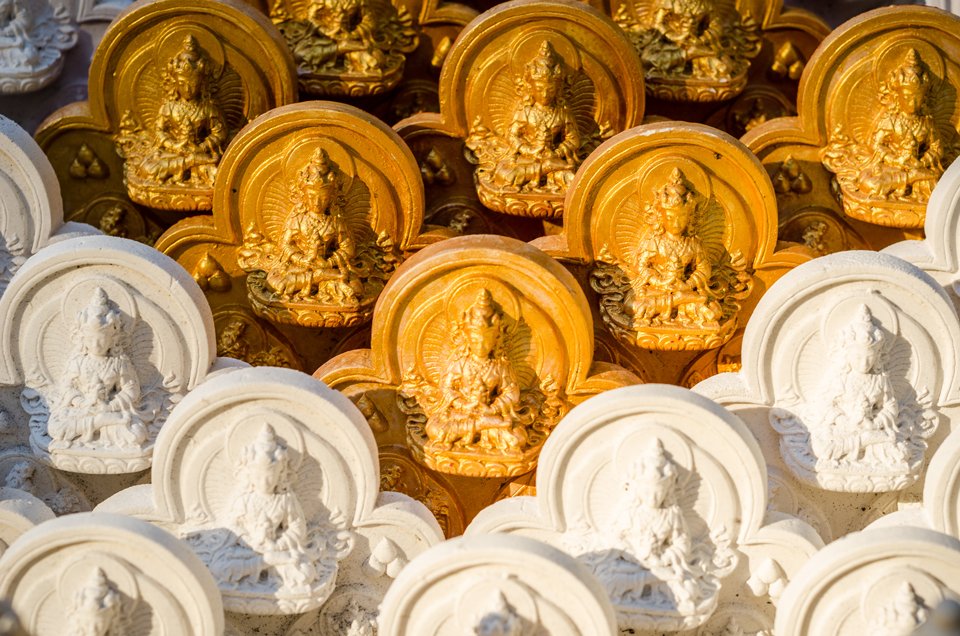
Tsa-tsas at Kachoe Dechen Ling, Aptos, California, US. Photo by Chris Majors.
Lama Atisha gave this advice on how to dedicate tsa-tsas to Zue Dorje Gyaltsen (zus.rdo.rje rgyal.mtshan). Then Dorje Gyaltsen gave this practice to Geshe Drogpo Kharpa (dge.bshes grog.po mkhar.pa). Then he gave to Geshe Draknakpo (dge.bshe brag.nag.pa), who gave to Gomrimpa (sgom.rim.pa), then he gave to Droe (grod) then he gave to Zhang (zhang) and then he gave to Chim (chim).
This is Lama Atisha’s tradition of practice for making tsa-tsas, his holy heart practice. This is how he practiced. It is very inspiring. It gives incredible inspiration; then one wants to make tsa-tsas.
This is the idea of totally mad Zopa. In the West it is easier [to do this practice] as tsa-tsas are not made from earth dust. It’s plaster. So you can make many tsa-tsas at one time. You can dedicate each tsa-tsa, according to what Lama Atisha explained. You can do like that or if you want to do more then you can dedicate for each two tsa-tsas, each three tsa-tsas or five tsa-tsas, like that. You can do like that. And if you don’t have time at all, if you are going to die right now, then make one tsa-tsa before the breath stops. Make one tsa-tsa but dedicate that for all the nine purposes, the nine reasons.
Okay. [You are] most welcome to enlightenment and to liberate sentient beings from the oceans of samsara as quickly as possible and to bring them to enlightenment as quickly as possible.
Thank you very much. Thank you very much.
Lama Zopa Rinpoche
Scribed by Ven. Tenzin Namdrol, Kopan Monastery, Nepal, January 2021.
For more on tsa-tsas, please see the tsa-tsa resource page:
https://fpmt.org/education/practice/holy-objects/tsa-tsas-a-resource-guide/
Watch Rinpoche’s recent teachings and find links to transcripts, MP3s, additional practice advice, and more on the page Lama Zopa Rinpoche’s Teachings on Thought Transformation during the Time of COVID-19.
Lama Zopa Rinpoche is the spiritual director of the Foundation for the Preservation of Mahayana Tradition (FPMT), a Tibetan Buddhist organization dedicated to the transmission of the Mahayana Buddhist tradition and values worldwide through teaching, meditation and community service.
8
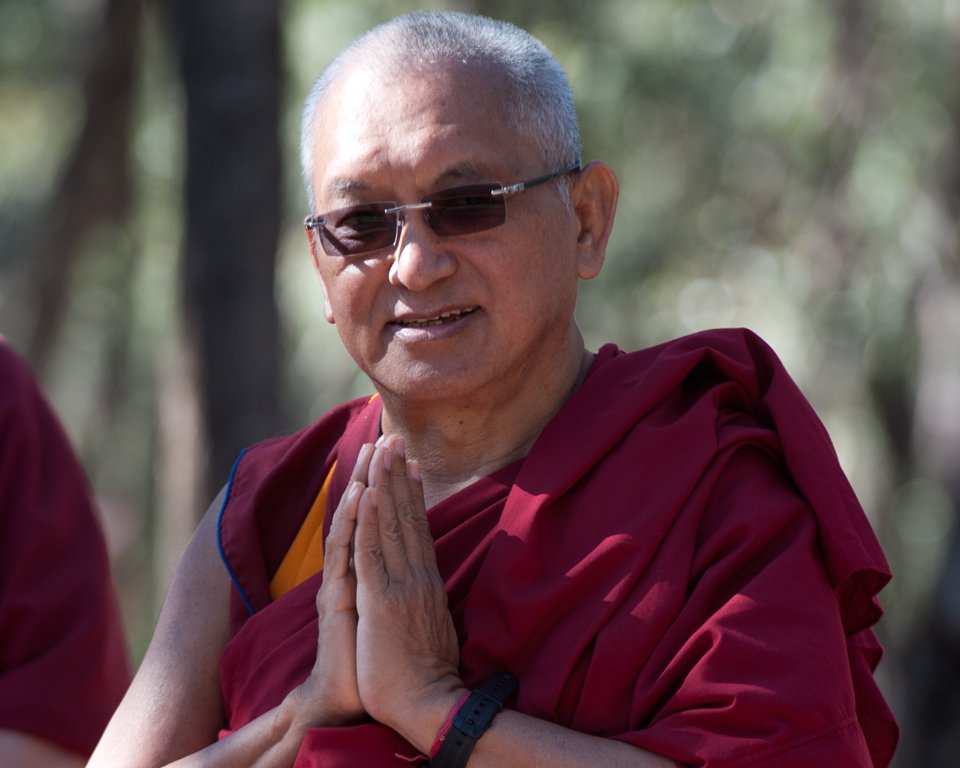
Lama Zopa Rinpoche at the Great Stupa of Universal Compassion, Australia, April 2011. Photo by George Manos.
Lama Zopa Rinpoche discusses reincarnation in a newly published archival video clip. During a quiet moment at the April 2011 retreat at the Great Stupa of Universal Compassion near Bendigo, Australia, Rinpoche gave an informal talk that was recorded by Ven. Thubten Kunsang, who traveled with Rinpoche, recording Rinpoche’s teachings and taking photos. The video was recorded before Rinpoche manifested a stroke at the retreat. Here’s a summary of the video:
Rinpoche begins by explaining that when someone dies, their body disintegrates and becomes dust, but their mind doesn’t stop. Their mind continues.
Rinpoche then offers the example of a family with children from the same mother. Some of the children in the family may be very intelligent or very compassionate, but sometimes there might also be a child who is very foolish and ignorant. One child may cry if they see someone else being beaten or even an insect being killed. That child can’t stand seeing others hurt and cries because of their compassion. And then, from the same mother, there may be one child who doesn’t care about this and maybe themselves want to kill.
Rinpoche explains that this shows that the minds of the different children didn’t come from the mother’s mind. The mind has its own continuity and is settled upon the body. The body of a child comes from their parents. But their mind doesn’t come from the parents. The mind has its own conditions from before.
So if in a past life one was more compassionate, the mind was trained in that, and the result is that in this life, they are compassionate, Rinpoche explains. Similarly if one was more angry in a past life, then the mind was trained or habituated to anger, which describes the result in this life. So there’s a cause from before a child takes birth in the mother’s womb that has a consequence in the present life. In past lives there were certain negative actions done, which polluted the mind. And so then there’s the result of that.
Rinpoche then talks about a book that he has in which a professor collected examples of children and older people who could remember their past lives. These are people in the West, but their stories are hidden and not part of the culture. They were discouraged from sharing their stories. Then there are people who can see other people’s past and future lives.
However, Rinpoche explains, there’s nobody who discovered or who realized that there’s no past and future lives and that there’s no reincarnation and karma. There’s nobody who has discovered or realized there is only one life. Many people have just assumed this or were taught this, but there’s nobody who realized this. Rinpoche concludes by explaining that those who have realized past and future lives are numberless.
You can watch the video “Lama Zopa Rinpoche on Reincarnation, April 2011”:
https://youtu.be/tL5dwNcN1BE
Watch the video series Lama Zopa Rinpoche’s Teachings on Thought Transformation, where you can also find links to transcripts, MP3s, additional practice advice, and more. You can also read a summary of Rinpoche’s thought transformation teachings given in 2020 in the Mandala 2021 article “The Time to Practice Is Now.”
Lama Zopa Rinpoche is the spiritual director of the Foundation for the Preservation of Mahayana Tradition (FPMT), a Tibetan Buddhist organization dedicated to the transmission of the Mahayana Buddhist tradition and values worldwide through teaching, meditation and community service.
- Tagged: bendigo, great stupa of universal compassion, lama zopa rinpoche, reincarnation, ven. thubten kunsang, video
2
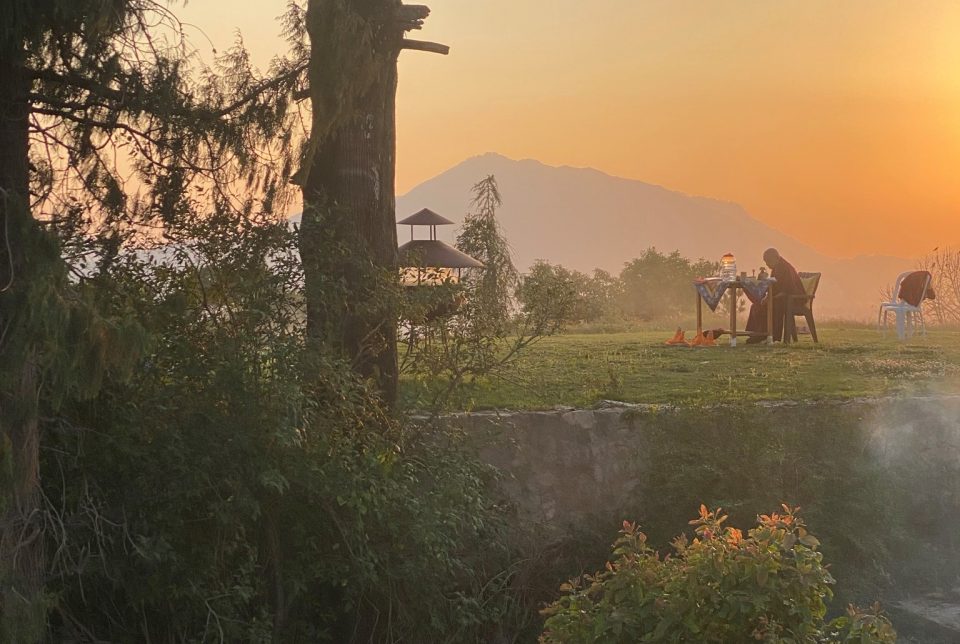
Sunset on Kopan Hill while Lama Zopa Rinpoche is offering puja, May 2021. Photo by Ven. Roger Kunsang.
Recently Lama Zopa Rinpoche offered some advice for those experiencing the intense heatwave in the Pacific Northwest of the United States. In the midst of record-high temperatures, Rinpoche advised on how to look at our present difficulties as an opportunity to practice by utilizing our suffering as a pathway to the greatest happiness by cultivating bodhicitta, and especially, by taking all the suffering of every sentient being upon ourselves so that they may receive enlightenment. Additionally, Rinpoche recommends making strong, heartfelt prayers to Chenrezig for the blessing of rain. We hope that you will find this advice from Rinpoche useful:
First, think about karma, cause and effect. In Tibetan, ledre. Secondly, think about how Lama Atisha had 157 gurus and two root gurus. One was Lama Serlingpa, from whom he received bodhichitta teachings in Indonesia for twelve years, like however much nectar one pot has being poured completely into another pot. Lama Atisha had to travel twelve months by boat in dangerous conditions to Indonesia to receive these teachings.
The other root guru is Lama Dharmarakshita, who gave the teaching of the Wheel of Sharp Weapons. One stanza from that says that when you have unbearable pain or disease, it’s due to you giving harm to others—the wheel of sharp weapons (bad karma) turned on yourself.
So now, you take all the pain, or the disease, onto yourself. This is what makes your pain or disease most worthwhile, causing all the sentient beings to achieve full enlightenment. So this means you experience every sentient being’s suffering and they become free from the entire suffering of samsara and achieve full enlightenment.
Actually it is sooooo precious. It harms your worst enemy—the self-cherishing thought that has caused you to suffer from beginningless rebirths in samsara, including causing samsara without end. If you don’t practice holy Dharma, particularly bodhichitta now, then you will have to continue suffering
That selfish mind has caused you to harm every sentient being. They suffer in the past and present and also future. You can’t imagine! This time and opportunity is soooo precious to destroy the enemy of bodhichitta. Not only mine, but every sentient being’s. As for others—I don’t know about people—but animals might suffer and die; even in the caves they have no air-conditioning or fans.
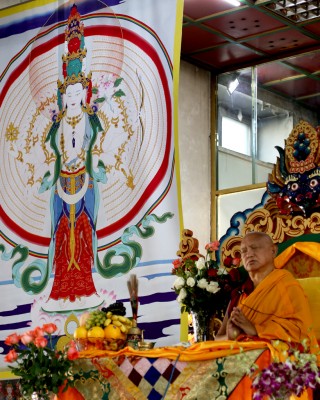
Lama Zopa Rinpoche teaching in front of 1,000 Arm Chenrezig, Ulaanbaatar, Mongolia, August 2014. Photo by Ven. Roger Kunsang.
Make heartfelt prayers to Chenrezig. In front of the statue, recite the Chenrezig mantra, some malas.
Make very strong prayers. You should know that Chenrezig is there, he sees and understands everything. Then request what is the most important need for sentient beings, which is black clouds and so much rain for a long time. Then that causes landslides and water floods—I’m joking! Visualize strong rain in the whole area where there is heat.
From the second buddha, Nagarjuna, who mentioned in A Letter to a Friend [as a comparison to the suffering in hell], “Here, having put 360 short spears heavily into the body,” there’s no need to question about that. For us, even a tiny thorn the size of a hair, if it goes in the flesh it’s unbearable without taking it out. So imagine the example of the 360 short spears—most unbelievable, unbelievable suffering.
Therefore, there’s no comparison [including having 360 short spears in the flesh] to the unbearable, unbearable, extremely unbearable suffering of even the slightest hell. And then there’s having to experience it for one hundred eons or ten million eons.
So until the negative karma finishes, one never separates from suffering. This is something to think about when we think about lower realm sufferings every day. This is the most unbearable, and it’s the very smallest hell suffering.
As I often say, the heaviest suffering of human beings is actually great peace and pleasure when compared to the hell sufferings. So you can understand from this quotation. Whether you believe that hell exists or not is just the limitation of merit, of intelligence. Those who have a lot merit, they can remember past and future lives. They have merit, like those bodhisattvas who achieve the bhumis. The bodhisattvas who achieve the first bhumi can see one hundred past and future lives. And on the second bhumi they can see one thousand past and future lives. Then more and more … it goes on and on. The higher and higher they go, the fewer and fewer obscurations.
It’s like the more you clean it, the more you see the beauty—the color and design comes out. The more you clean the dirt it becomes clearer, so the quality of the mind comes out. That’s a very good outside example.
For example, a cup is dirty and smelly with kaka, but because the cup is not kaka you can clean it with soap and water. It’s the same with cloth that is very black and dirty, you can wash it with soap and different things, and then it becomes fresh like a new one, especially if you iron it. So that’s a very good outside example. Because the cloth isn’t oneness with the dirt, it’s just temporarily obscured. The mind is also not oneness with the obscurations, not oneness with attachment, anger, and ignorance—ignorance holding I and phenomena as truly existent. While it exists in mere name, not even an atom is existing from its own side.
So it’s an example, and through meditation, if you really meditate, if you get experiences, you see more and more clearly past and future lives, karma, with higher and higher realizations. As the mind gets less and less obscured and purified, then you can see things deeper and deeper, what ordinary beings cannot see. It doesn’t mean just because you can’t see it now [it doesn’t exist]. When the mind has fewer obscurations through purification, you can see for yourself, you can prove to yourself.
Now here as I mentioned, this shows very clearly the example of hell sufferings. It’s not hell but it’s giving an example. It’s a human being suffering, but it’s like hell, it gives you an idea—then, it becomes unbelievably hot, beyond human suffering. The heat is there, it’s the same as in Bodhgaya where it’s hot every single year. It’s not been in America, but now it happens. In India, in Bodhgaya, it happens every year. It’s just that we don’t know about India. So you see, this didn’t come from the outside, it came from the mind.
Nearby, there’s a part of America—the name I don’t know—it’s in the corner of America, there is so much water, so much flooding, so much of that has happened. Then in Washington it’s so hot. Some areas are very hot while close by there is flooding. It looks like it comes from outside, but it comes from the inside—the mind—the result of past negative karma.
The foundation of Buddhism is that happiness and suffering come from the mind, from your mind. So your mind is the creator. It’s explained in Abidharmakosha, this is one important subject to study. The various worlds came from the mind, born from the mind. It’s either so hot, or there are landslides or earthquakes. These outside conditions are caused by non-human beings. But that’s not the main cause. The main cause is karma. Karma is the mind; it is not the body. It comes with the mind, not with the body. There is the primary mind and the fifty one mental factors. There are five omnipresent mental factors, in Tibetan, kundro nga, always existing—“omnipresent,” as it’s translated in English is okay but it’s not very exact. Karma is the mental factor intention, which is one of those five.
Yes, of course it can be purified before experiencing the result. Yes, it depends on how perfectly it’s purified, whether you experience some result or not. If purification is perfectly well done, then one never experiences the result of negative karma, suffering is not experienced in this life. Then the next one is that you experience past heavy karma in this life, but not as heavy as experiencing it in the lower realms for many eons. Unbelievable heaviness, but it manifests as some cancer or virus, some chaos to finish. So there will be happiness in the future. These are the benefits of purification.
Kadampa Geshe Kharagpa said, “This small present suffering finishes some past negative karma, then there will be happiness in the future. So therefore, be happy by having this suffering.” I think it means to rejoice and be happy by thinking of the benefits. So not just in one life, but from life to life, you’ll have more and more happiness. Also, you go to enlightenment and are free from samsara. It can happen more and more like that.
So it’s very good to rejoice. You’re experiencing the hottest heat now, but in Bodhgaya, where we have a center, the people who live there go through this every year, so hot. That’s what Roger reminded me. In America it’s a big surprise because it didn’t happen like that before. So you have to know and you have to rejoice. Be happy because your past negative karma is getting purified, purified of the lower realm sufferings, unbelievable sufferings. It finishes like that, so rejoice, be happy.
And not only that, be happy to receive all the numberless sentient beings’ sufferings—the hell beings, hungry ghosts, animals, human beings, suras, and asuras—to take their suffering on yourself. Experience that suffering and the causes—karma and delusion—and let them be enlightened, the total cessation of obscurations and the completion of realizations.
Experience it for sentient beings rather than thinking, I’m suffering, I’m suffering. Unless of course, you want to fly to Mount Everest. So you see, in the northern hemisphere, in Iceland and in many places, there are huge ice mountains melting down. You hear about this all the time. Why is this happening? It came from the mind, basically. The great enlightened being, Padampa Sangye, who existed during Milarepa’s time said, “It looks like happiness and suffering come from the outside, but they come basically and originally from one’s mind.”
So you can ask, the virus came from China, but why does it have to be experienced in America? Some people have the virus while some people don’t have it—why? Also in the family, the father can die from the virus but not the children and not the mother—why? So you can ask like that.
You want to see yourself as an enlightened being and others as ordinary beings—this is totally ignorant because you don’t understand it came from the mind. Using a very simple example, when you recognize that you’re not well, that you’re sick, you go to the doctor. Because you don’t know how the sickness evolved, you don’t know the details, what happens with the sickness—you have no idea, so you go to see the doctor who knows better than you, who has studied more and who knows more than you. But you say this doctor is totally ignorant because he doesn’t know more than me, he hasn’t stopped suffering and ignorance up to thinking, “I’m an enlightened being,” and you disregard his advice.
So whatever is happening—the extreme weather, whatever it is that totally changes and then there’s suffering, hot, cold, big problems—you experience it for others. If you have intelligence, if you have a lot of merit, then you experience it for sentient beings. In that way you actualize the path to enlightenment. Then not only do you get enlightened but you enlighten other sentient beings. It’s so good, unbelievable. And if you die with that, as His Holiness always says, the best way to die is with bodhichitta.
Kyabje Khunu Lama Rinpoche, the great bodhisattva from whom I received teachings, said in the Praise to Bodhicitta that even if you’re sick, be sick with bodhicitta; even if you die, die with bodhicitta. Whatever happens, that is best. The Kadampa Geshe Chekawa said that he prayed to be born in the hells for sentient beings, but at death time he had visions of the pure land where he’d be reborn. He said, “I didn’t achieve my wish, which was to be born in the hells for sentient beings.” He treated all sentient beings like how you would treat your mother or the most kind person. Their suffering being the most unbearable, he felt it for all sentient beings—for every ant, every mosquito, even the tiniest one, everyone, no matter how big they were—he felt it for everyone.
This is the best way to die and to experience problems. It’s the best way to transform it all into the path for all sentient beings. What else is more happiness than this and more important than this, to be able to benefit numberless sentient beings? It’s ridiculous to take drugs or whatever. It’s like a person who has delusions from spirits, that person is running on the cliffs and in his vision, his view, there’s a big road that goes down to the beach. This is explained by not just one person, but quoted by those who didn’t die. They explained what they have seen, where there’s actually no road, they see a road.
Thank you very, very much. I bring up some words for this situation where everybody is jumping [with anxiety]. There are many stories with the heat, but one can’t jump that much. So please think about what I’ve said. The best is tonglen [taking and giving] and lojong [thought transformation]—the most beneficial. Whatever it is, even death, sickness, or relationship problems, experience it for all sentient beings. That’s the happiest and the hippiest person.
Thank you very much. Goodbye.
Dictated to Ven. Tenzin Namdrol by Lama Zopa Rinpoche at Kopan Monastery, Nepal; transcribed and lightly edited by Wongmo, Buddha Amitabha Pure Land, June 30, 2021. Further edited by FPMT International Office, July 2, 2021.
Lama Zopa Rinpoche is the spiritual director of the Foundation for the Preservation of Mahayana Tradition (FPMT), a Tibetan Buddhist organization dedicated to the transmission of the Mahayana Buddhist tradition and values worldwide through teaching, meditation and community service.
Learn more about the recent video series Lama Zopa Rinpoche’s Teachings on Thought Transformation, where you can also find links to videos, transcripts, MP3s, additional practice advice, and more.
- Home
- News/Media
- Study & Practice
- About FPMT Education Services
- Latest News
- Programs
- New to Buddhism?
- Buddhist Mind Science: Activating Your Potential
- Heart Advice for Death and Dying
- Discovering Buddhism
- Living in the Path
- Exploring Buddhism
- FPMT Basic Program
- FPMT Masters Program
- FPMT In-Depth Meditation Training
- Maitripa College
- Lotsawa Rinchen Zangpo Translator Program
- Universal Education for Compassion & Wisdom
- Online Learning Center
- Prayers & Practice Materials
- Overview of Prayers & Practices
- Full Catalogue of Prayers & Practice Materials
- Explore Popular Topics
- Benefiting Animals
- Chenrezig Resources
- Death & Dying Resources
- Lama Chopa (Guru Puja)
- Lama Zopa Rinpoche: Compendium of Precious Instructions
- Lama Zopa Rinpoche: Life Practice Advice
- Lama Zopa Rinpoche Practice Series
- Lamrim Resources
- Mantras
- Prayer Book Updates
- Purification Practices
- Sutras
- Thought Transformation (Lojong)
- Audio Materials
- Dharma Dates – Tibetan Calendar
- Translation Services
- Publishing Services
- Teachings and Advice
- Find Teachings and Advice
- Lama Zopa Rinpoche Advice Page
- Lama Zopa Rinpoche: Compendium of Precious Instructions
- Lama Zopa Rinpoche Video Teachings
- ༧སྐྱབས་རྗེ་བཟོད་པ་རིན་པོ་ཆེ་མཆོག་ནས་སྩལ་བའི་བཀའ་སློབ་བརྙན་འཕྲིན།
- Podcasts
- Lama Yeshe Wisdom Archive
- Buddhism FAQ
- Dharma for Young People
- Resources on Holy Objects
- Ways to Offer Support
- Centers
- Affiliates Area
- Teachers
- Projects
- Charitable Projects
- Make a Donation
- Applying for Grants
- News about Projects
- Other Projects within FPMT
- Support International Office
- Projects Photo Galleries
- Give Where Most Needed
- FPMT
- Shop
Translate*
*powered by Google TranslateTranslation of pages on fpmt.org is performed by Google Translate, a third party service which FPMT has no control over. The service provides automated computer translations that are only an approximation of the websites' original content. The translations should not be considered exact and only used as a rough guide.Buddhism is not at all a tactful religion, always trying to avoid giving offense. Buddhism addresses precisely what you are and what your mind is doing in the here and now. That’s what makes it so interesting.


